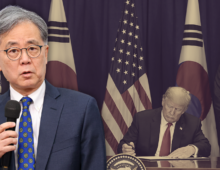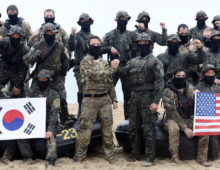|
Analysis Why conferences in Korea are (mostly) a waste of time and resourcesOverfocus on prestige signaling makes for pretty settings but little substance or real debate, experts say Chad O'CarrollNovember 24, 2022  Empty chairs in a conference hall | Image: Jonas Kakaroto via Pexels Conferences on ill-defined themes and hundreds of speakers with little related expertise. Panels crowded with more than a dozen speakers at a single time. Slides overflowing with text. Lineups featuring no women whatsoever. These are just some of the issues regularly plaguing South Korea’s conference circuit, which despite being an industry worth almost U.S. $10 billion, rarely sparks actual debate or provides information that wasn’t easily available online. A rigid top-down approach to event management is often why conferences exhibit the same issues over and over again, and the events are envisioned as signaling mechanisms for prestige rather than substantive mediums for dialogue, multiple participants and attendees of conferences in the country told Korea Pro. Across the board, a culture that values style – not substance – explains why questions and debate are so often overlooked as a key part of proceedings, according to Kim Han-ul, a bilingual MC that has led scores of conferences and panels in Korea. She said conference organizers in South Korea are mostly concerned with the opening and the closing. “They don’t really care about the middle part, they just care about the first impression and the last impression.” This typically manifests with flashy videos and graphics presented at the beginning and end of conferences, Kim added. The focus on style over substance typically means conferences are held at prestigious hotels, and there is an extreme push to get one or more “high-profile” guests — many times from abroad. “There is often a requirement in South Korea to get a ‘name’ speaker to attract a crowd,” said a senior retired diplomat often flown out to Seoul to participate in conferences. Usually, the name is all that matters and organizers don’t care whether the person “is no longer a player, is out of sync with his/her own country’s policies, and also out of sync with the ROK government’s perspective and what mainstream Koreans are thinking,” they said on condition of anonymity. Michael Breen, head of public relations agency Insight Communications in Seoul, said that a consequence of this approach is that discussion is often “weak, disappointing or just puzzling from a content point of view.”  Presentations in South Korea often feature an over-abundance of written text on slide designs | Image: Korea Pro ALL NOISE, NO SIGNAL South Korean conferences are also jam-packed with speakers and long, text-based presentations that can last an entire working day, several conference participants told Korea Pro. “There is usually a requirement for panelists to produce a written paper for Korean conferences which can lead presenters to read their papers at great length,” said Bruce Klingner, a senior research fellow at the Heritage Foundation. As a result, presentations are too long and there’s not enough time for “thought-provoking” discussion, Kim the MC said, adding that Korean conferences don’t typically offer attendees anything they couldn’t easily get online or by downloading the papers written for the conference. There are “lots of tedious slides and little focus” on the topic of discussion, agreed Jeffrey Bohn of the Seoul-based consulting firm Edge Communications. In addition, the large number of participants further compresses time for creativity and genuine back-and-forth. Some conferences feature as many as 13 panelists talking over a single two-hour period, Korea Pro research shows, meaning less than 10 minutes of discussion per person per event. Klingner of Heritage said he has often participated in or attended panels with a large number of people on-stage. They “generally have four panelists, four commentators and a moderator who either acts as a ninth presenter or summarizes what the audience has just heard,” said Klingner. These commentators have “no set parameters” which can lead to some presenting “their own views” or just picking apart other panelists’ arguments, he said. That also means there is seldom any time for questions from the audience, he added. Worse, “some organizations use chairpersons who try to summarize the comments of the panel members,” said the senior retired diplomat. “That seems like a colossal waste of time, since the audience already knows what it has heard.” This also eats into time that could be spent digging deeper into ideas presented or building on interesting themes presented. Instead, “there’s not a lot of time for debate or ideas being challenged or things like that,” Kim the MC said.  Having a dozen or more speakers on stage at once is common in many Korean conferences | Image: Korea Pro GENDER IMBALANCE An even bigger problem in the Korean conference industry is the few opportunities for women to present or participate. “Manels” — event lineups or dozen-plus speaker panels composed only of men — are the norm in South Korea, even at higher profile internationally-focused conferences sponsored by the national government. “Looks like an interesting sunshine policy conference but ..erm.. are there NO WOMEN available to discuss peace on the Korean Peninsula? Really??” tweeted former BBC Korea correspondent Laura Bicker in response to a Ministry of Unification event in 2019. “I just checked out the program for the @ALCChosun conference in Seoul next week and you’ll never believe what I found. OK, you will totally believe what I found. Manel after manel,” tweeted then-Washington Post Seoul Bureau Chief Anna Fifield in 2018 about a Chosun Ilbo event called the Asian Leadership Conference. Andrew Yeo, the SK-Korea Foundation Chair at the Brookings Institute in Washington, D.C., acknowledged an “uneven gender balance” in some key areas, such as foreign policy and national security. Kim the MC agreed: “When it comes to defense and national security, I think there is unanimous vote that there’s a huge lack of female experts.” But she and another MC added that gender balance isn’t as much of an issue in other popular conference topic areas, such as those relating to startups, domestic regional issues and urban planning, for example. The Korean conference industry is not all bad, though, and some interviewees noted that there were aspects that should be praised. “They’re able to get all these speakers from different parts of the world to join a conference, I think that is pretty impressive,” said Kim the MC. That’s because, according to a former Korean think tank conference organizer who requested anonymity, event planning staff are “very fast” and “very organized” in terms of coordination. In addition, frequent conference participants told Korea Pro that ROK-based events also served a valuable professional purpose. “American experts greatly appreciate the opportunity to engage with Korean experts both during the conference and on the sidelines,” said Klingner of Heritage. Ramon Pacheco Pardo, the Korea Foundation-Vrije Universiteit Brussel Korea Chair, noted that “many conferences these days mix private and public sessions,” explaining he finds the former more helpful for his research interests. And though it’s possible to keep in touch with ROK-based peers through other means, Yeo of Brookings said that “Korean hosts seem committed to informal gatherings and networks” in a way that doesn’t take place around American events. In the U.S., he said, “half the participants may want or need to go home for family obligations, other engagements and so forth.”  Gender balance is seldom thought about in the design and preparation of conferences in South Korea | Image: Korea Pro PRESTIGE SIGNALING Observers shared a range of explanations for the problems plaguing Korean conferences. Factors include the belief that events help legitimize individual programs of work and even entire institutions, as well as promote new government policy initiatives and project “national consensus” levels of support. In contrast, interviewees said the quantity-over-quality approach to session design and widespread gender imbalance problems more likely relate to cultural issues in South Korea. Conferences “are for the organizers to kind of prove that they’re doing something meaningful with their time and money,” said Kim, the MC. The former Korean think tank organizer agreed: “Oftentimes I feel like the meaning of holding a conference is just holding the conference itself.” The focus is on projecting prestige and high-level connections and signal that “we are doing something and we are working toward something,” said the former Korean think tank organizer. “It’s really like ticking a to-do list.” Tom Coyner of Sotftlanding Consulting, who has attended dozens of events in the ROK over several years, agreed: “They want to see who spoke and how many people attended and if there was anyone of special relevance/importance in the audience,” he said. “In other words, too often these conferences have become primarily sponsor/organizer prestige-building exercises,” Coyner added. “I doubt sponsors ask, ‘Well, how clear were the conference’s objectives?’”  Events in Korea often include valuable informal networking sessions as well as reliable logistics | Image: Andrea Piacquadio via Pexels CULTURAL EXPLANATIONS Another factor contributing to the staid and clunky format of Korean conferences, orthodox speakers and the abundance of manels is the cultural characteristics of the ROK itself. “The business culture in Korea can still be remarkably top-down and task-oriented in the way you find in the military,” said Breen of Insight Communications. “This would explain the good logistics — but it can also explain poor content in that people responsible lack the experience or are not given the leeway to be creative in developing a program.” This means that the intended audience for Korean conferences may be the organizers themselves — not the attendees or participants. “The real audience for any employee is their boss [and] employees will only put consumers first if required to,” Breen continued. “If the bosses are egocentric, want to promote themselves or lack a feel for the issues, the employee will be distracted.” In addition, the former think tank organizer said that so many of the key decision makers at Korean conferences are in positions for long periods of time and are reluctant to try anything new. “It’s really the same old people organizing events,” they said. “So there’s no real exchange of views (with younger staff) in terms of who to invite or what kind of discussions or what kind of format would be good.” This old boys’ club approach to conference planning infrastructure leads to gender imbalances. “I think this is a serious issue that is visible not only in conferences but also in the wider Korean society,” said a Korean policy insider with experience in both private and public research institutions. “The lack of diversity may be more so in conferences because educational/public institutions are very hierarchical and have a seniority system in which women have disadvantages.” But they added that Korean organizers, especially older ones, “don’t even realize that such a problem exists.” The former think tank organizer agreed: Comments from conference participants about the need for more women were “not taken very seriously” by Korean organizers. A Korean cultural focus on seniority is likely contributing to the problem, said Yeo of Brookings. “There are a number of excellent female analysts and scholars out there, many who might be seen as rising stars or emerging scholars,” he explained. “But they are still operating at the junior level, and conference organizers may pass them over for their more senior (and often male) colleagues.” And Kim the MC said there was also a structural prejudice against women in areas like military expertise. “No matter how experienced you are as a female, there’s that nuance that, oh, you don’t really know what you’re talking about because you’re a woman and you’ve never been to the military,” she said. All South Korean men serve in the army under a national conscription system.  Conferences in Korea normally include a photo session to document the event for posterity | Image: Korea Pro ESTABLISHING ‘NATIONAL CONSENSUS’ Meanwhile, the South Korean government often sees conferences as a necessary practice to legitimize some policy, statement or trend. “The main aim of these events is to gain policy legitimacy … [which is] most visible after the government announces policies that seem distinctive, politically or diplomatically,” said the Korean policy insider. One such example was when the former Moon Jae-in administration dived headlong into engagement with North Korea, resulting in a flurry of “peace forums” all over the nation — often on large budgets and at significant scale. “The government uses such events to explain their new policies to professionals as well as the public,” the policy insider explained. “Usually, a large number of people who support the new policies/strategies come to these events and it would seem like there is strong consensus in the society.” That’s why there are often so many people on stage; the utilization of ambiguous panel topics helps create ties to other panels, enabling the government host to bring in so many speakers to each session. “These events are also used as tools to distribute rents not only to your supporters but also those who are critical, and to solidify support for your policies,” the insider continued. By hosting at expensive hotels, instead of local government halls or venues, organizers can more successfully convince critics of a new policy and change their way of thinking, the insider explained. The insider, who has been involved in government-linked events, told Korea Pro that panelists may be paid hundreds of dollars to speak for just a few minutes. Then, surrounded by five-star luxury accommodations and other “big names” around you, one is primed to change their thinking in a way that more aligns with the government, they said. And though the insider said similar approaches may take place in other countries, “it feels like there are way too many conferences with these characteristics in Korea.”  When new policy goals are established, extended conferences including dozens of speakers can appear to give a sense of consensus | Image: Korea Pro CHANGING THE SCENE With so much spent on events and conferences in South Korea, there is a lot of potential for change and growth. As mentioned above, frequent conference participants can find positive attributes — such as implementation, speedy turnarounds and emphasis on networking outside the event — that organizers in other countries could learn from. “If we want to see more of these conferences providing more value, I think there should be more debate,” said Kim the MC. That, in turn, could lead to larger portions of the general public being interested, versus the typical audience blend of invited speakers, host staff and fellow industry peers, she said. Featuring more women would also make sense, she and others said. “If they went out and looked for the best people, many will be female,” said Bohn of Edge Communications. And if events don’t start improving, it’s likely that they could become increasingly irrelevant, Coyner of Softlanding Consulting said. “Why leave one’s office, home [or] nation to travel to some place at the expense of time and money when one can get 90% of the value online … often for free or little cost?” Yeji Chung contributed to this report. Edited by Arius Derr. Conferences on ill-defined themes and hundreds of speakers with little related expertise. Panels crowded with more than a dozen speakers at a single time. Slides overflowing with text. Lineups featuring no women whatsoever. These are just some of the issues regularly plaguing South Korea’s conference circuit, which despite being an industry worth almost U.S. $10 billion, rarely sparks actual debate or provides information that wasn’t easily available online. Get your
|
|
Analysis Why conferences in Korea are (mostly) a waste of time and resourcesOverfocus on prestige signaling makes for pretty settings but little substance or real debate, experts say  Conferences on ill-defined themes and hundreds of speakers with little related expertise. Panels crowded with more than a dozen speakers at a single time. Slides overflowing with text. Lineups featuring no women whatsoever. These are just some of the issues regularly plaguing South Korea’s conference circuit, which despite being an industry worth almost U.S. $10 billion, rarely sparks actual debate or provides information that wasn’t easily available online. © Korea Risk Group. All rights reserved. |











